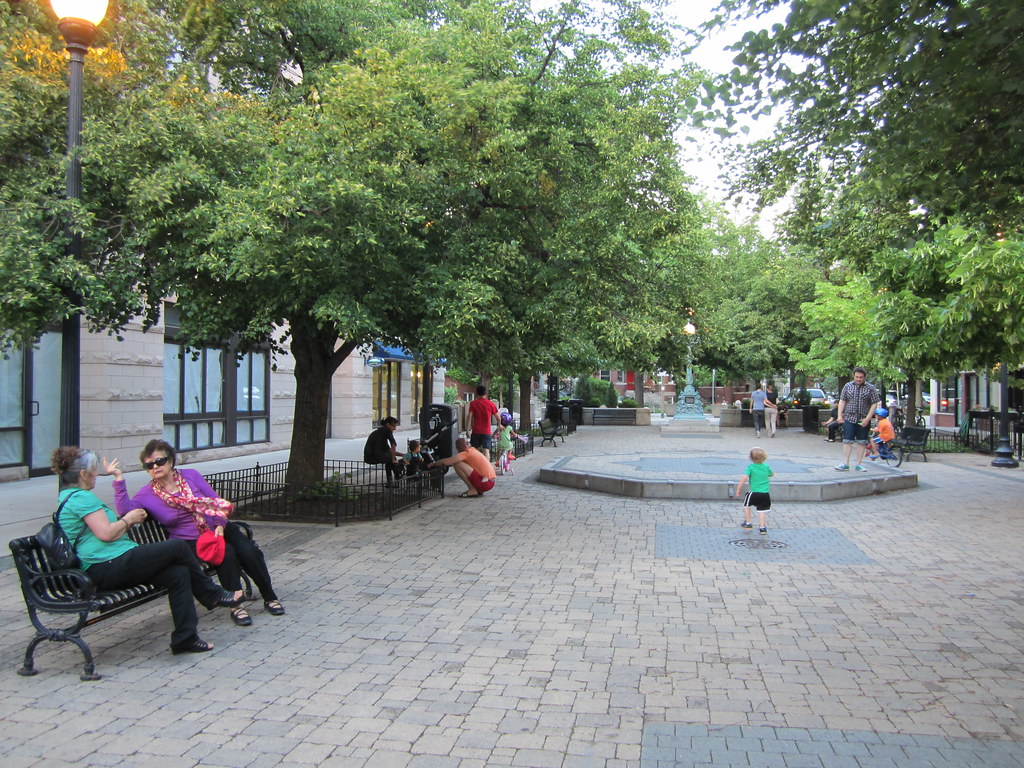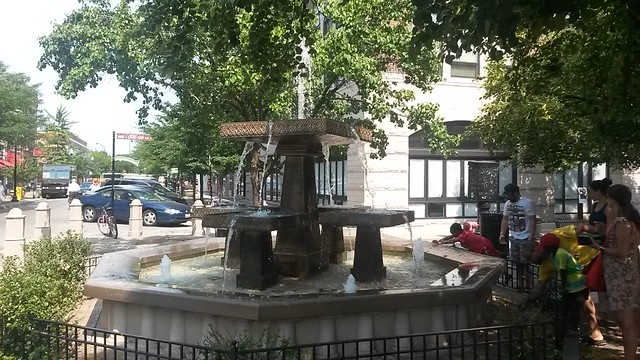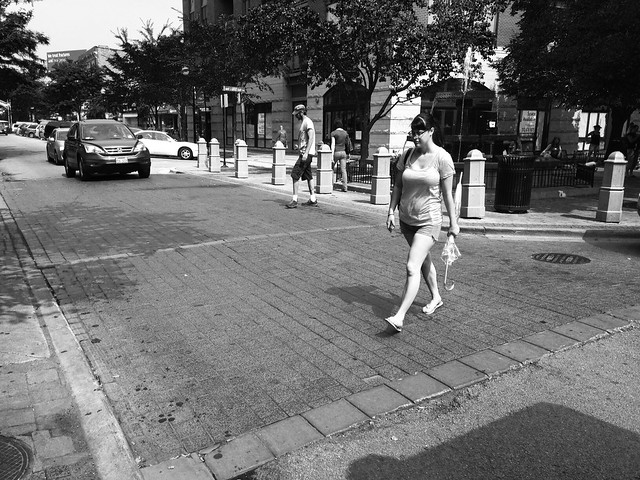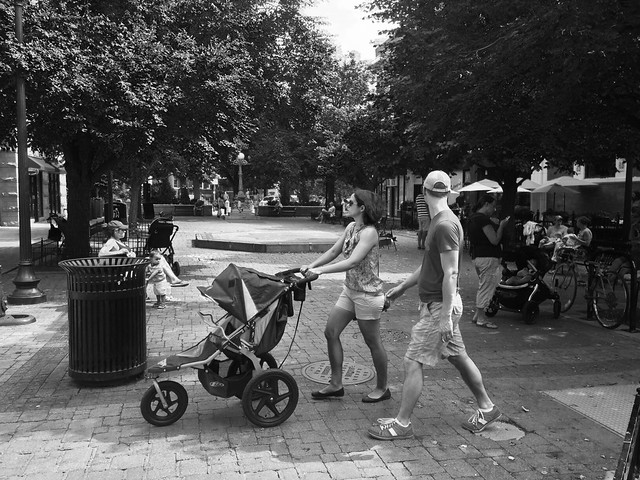Streetsblog will be on vacation on Monday, September 1. Enjoy your Labor Day!

There are few pedestrian spaces in Chicago that evoke the feeling of an old European city as well as Kempf Plaza (perhaps better known as Giddings Plaza) in the Lincoln Square neighborhood.
Now that city, advocacy groups, neighborhood organizations, and individuals call for more public plazas throughout the city, it would be instructive to examine the history and design features that make some of the city's existing public spaces successful. Kempf Plaza is often cited as an example to emulate. The plaza is a result of history and good design, 36 years in the making.

The area around the Lincoln Square neighborhood was settled as early as 1836, before Chicago was incorporated. The establishment of a streetcar line along Lincoln Avenue in 1872, and subsequently the parallel Ravenswood elevated line in 1907, spurred more intensive development, especially as immigrants from places like Germany streamed into the North Side. Beginning in 1949, the Lincoln Square Chamber of Commerce began promoting itself as a commercial district, but it wasn’t until 1978 that a more European flair was sought for the neighborhood, in order to help a cluster of businesses struggling amidst the city's then-declining economic fortunes. Any visitor today can attest that the area has a distinctly European feeling, including several Bavarian-style facades and painted murals of old European towns.
Just closing half a block to residential traffic, and removing a few parking spaces, doesn't suffice as a recipe for a successful public space. Several other public spaces, including some in Chicago, suffer a lack of vitality and are missing key elements necessary for a successful public place. What makes Kempf Plaza different?
Danish architect Jan Gehl written has several books related to the urban design of outdoor spaces. One of his books, Life Between Buildings: Using Public Space, is a thorough rundown of what makes a quality public space. Giddings Plaza qualifies as a third place, one that is neither home nor work, and is a space for optional activities, as opposed to necessary activities like errands or commuting. Optional activities, Gehl writes, “take place only when exterior conditions are favorable.” What are some exterior conditions that make this a great place?

Seating: Giddings Plaza is unarguably a great place to sit down and watch other people. The formal seating areas (benches) are found at the edge of the plaza facing inward, unobstructed, offering a view of the activity in the plaza. There are also movable single chairs that can be used by a single person, moved to join a group, or even used as a footrest for people lounging.
Secondary seating is also important. When the plaza is particularly busy, people will sit on the narrow fences surrounding trees and the fountain, or on the raised stage in the middle of the plaza.
Seeing: The intimacy of the space creates an outdoor "room" where it is never difficult to see what is happening. There are also non-human objects to look at: a fountain and the Lombard Lamp, a 1979 gift from Chicago’s sister city of Hamburg, Germany. Both fixtures provide something for people to look at, whether children climbing on the lamp or the bands that frequently play live music in front of the fountain.

Hearing and talking: The background noise level is quiet, thanks in part to the low and slow traffic on Lincoln Avenue and the fountain, which helps buffer the noise of traffic and adds a pleasant background sound even when there's no activity. In the summer, there is usually some music, but rarely loud enough to drown out conversation. It's easier to chat with friends, family, or strangers thanks to moderate noise level.

Sense of place: Within a three-minute walk of Kempf Plaza is a lively streetscape of restaurants, bars, cafes, ice cream shops, delis, bookstores, salons, clothing retailers, specialty retailers, banks, grocery stores, and occasionally a food truck. On the levels above, there are numerous residences and offices. The businesses keep the area busy for as many as 20 hours per day, giving it an activity level unmatched in all but a few neighborhoods in Chicago. The primary effect is that people use the plaza throughout the day. A secondary effect is that the plaza feels safer, as there are almost always “eyes on the street” to protect it.

Protection from traffic: The plaza also benefits from the low risk of traffic violence, thanks obviously to the cul-de-sac on Giddings but also thanks to the traffic-calmed, one-way Lincoln Avenue adjacent to the plaza. The raised plaza extends beyond the curb to the west side of Lincoln, creating a "speed table" or raised crosswalk. This slows down drivers, and forces up to the level where people are walking. This is a subtle cue that drivers are welcome as guests, but within the domain of the people walking. The heightened safety of the car-free plaza is exemplified by the numerous parents who allow their children to run freely there. On most sidewalks, parents hold their children close to protect from the danger of moving traffic, whereas in plazas like this, parents are often found socializing while children play.
The most important success is that Kempf Plaza is a place where people will stay. Barring formal observational research, a casual observer can note that people who come by the plaza usually stay for some time. I’ve called the plaza the “neighborhood backyard": even though many of the homes in the neighborhood have their own yard, the one place that many people come to congregate is the plaza.
Kempf Plaza is often cited when people or neighborhood groups call for more plazas in Chicago. Not every location, though, is initially suitable for a plaza: some need more commercial and residential density to support a lively space, while others need to improve positioning or amenities to induce people to stay. There are a few basic requirements, exemplified in Kempf Plaza, that should be featured in any successful space: ample primary and secondary seating that faces inward, a focal point, a diversity of business (especially food), and adjacent streets that are relatively quiet and accessible. Some of these aspects are noticeably absent from other plazas or planned public spaces, and as a result these spaces are not as lively.
The most important outcome to remember is that Kempf Plaza was once a simple residential street, moving a few cars and storing several private vehicles. Initially, there was opposition from merchants and residents alike. In retrospect, the opposition was hyperbolic. Today, the space is popular, and acts as the center of the neighborhood. To remove it today would cause an uproar -- yet the result would be what some neighbors in the late 1970s wished for. This hindsight is important to remember whenever projects that reshape streets, and remove some room for cars (whether moving or parked) face opposition. With proper planning and care, they, too, can become the great neighborhood spaces that everyone in Chicago deserves.



